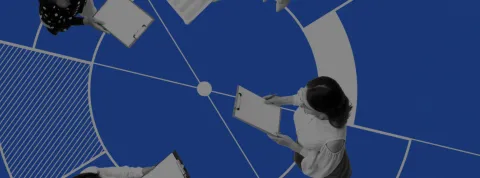
ICT in education: tools that are revolutionizing classrooms
Not so long ago, talking about ICT (Information and Communication Technologies) in education meant computer labs with machines that took ages to boot up, or CD-ROMs that promised the future of digital learning. The technologies were there, but they were still seen as a complement — a temporary aid rather than an essential part of the learning process. Today, however, the situation is completely different.
The arrival of the Internet in classrooms, the daily use of digital platforms, virtual learning environments, and artificial intelligence have radically transformed the relationship between teachers, students, and knowledge. Now, a classroom can be physical or virtual; a lesson can turn into an interactive game, an immersive experience, or a live conversation with experts on the other side of the world.
At Planeta Formación y Universidades, we observe and take part in this change every day, supporting thousands of students and teachers in developing digital skills that are no longer optional but essential to face the future.
What ICT in education is and why it’s key in the 21st century
When we talk about ICT in education, we refer to all those technologies we use to learn, communicate, and share knowledge — from computers and tablets to digital platforms and educational apps. Once seen as supplementary, these tools are now part of everyday life in every school.
Thanks to them, students can access materials from home, take part in forums, collaborate on projects with peers from other places, and receive personalised support. ICT also makes it possible to adapt content to each individual’s pace and encourages creativity through videos, podcasts, simulations, and interactive games.
ICT in the classroom: how it´s transforming the educational experience
For a long time, teaching followed a very linear model: the teacher explained, and students listened. Now, technology has broken that pattern. In many classrooms, students are no longer passive recipients but active participants. ICT doesn’t replace teachers — it transforms their role. Teachers become guides, facilitators, and curators of information.
From books to devices: a new way of teaching and learning
The book hasn’t disappeared, but it now coexists with screens, apps, and online platforms that expand the possibilities of the classroom. It’s no longer just about reading a text, but interacting with it: seeing how an experiment works, exploring a 3D map, or joining a live quiz. This transition from paper to device enables learning through multiple channels — image, sound, movement — and allows each student to learn at their own pace.
The role of ICT in boosting participation and motivation
When students feel actively involved, their motivation increases. ICT makes this possible: it allows them to participate, make decisions, and explore. An app can turn a complex topic into a fun challenge; a collaborative platform can connect students working from different locations; and a gamification tool can make an assessment a more dynamic experience.
ICT in primary, secondary and higher education: different approaches
Each stage of education has its own rhythm and needs. In primary education, ICT helps spark curiosity and develop basic skills through simple tools, games, and visual platforms.
In secondary education, the focus shifts to autonomy and teamwork: apps are used for projects, digital whiteboards for collaboration, and multimedia resources that invite reflection and debate.
At university level, ICT becomes an integral part of the learning environment: virtual campuses, collaborative tools, artificial intelligence, simulators, and online resources prepare students for an increasingly digital professional world.
At every stage, however, one thing remains true: technology doesn’t replace teachers or content — it enhances both.
ICT tools that are revolutionizing teaching
Online platforms and virtual learning environments
Today, it’s rare to find a classroom without some form of virtual environment designed to replace or complement face-to-face teaching. These platforms give students access to activities, study materials, and assessments anytime, anywhere. One of their greatest benefits is flexibility: learning no longer depends exclusively on a fixed schedule or physical presence.
Educational apps, gamification, and mobile learning
Beyond large platforms, there is a whole ecosystem of mobile apps and gamification tools making a major impact on education. Games, challenges, badges, interactive quizzes — all turn learning into an experience closer to “learning by playing.”
Moreover, mobile learning (m-learning) expands access, allowing students to engage with educational content from their devices outside the traditional classroom — during commutes, breaks, or from home.
Augmented reality, virtual reality and artificial intelligence in the classroom
Emerging technologies are also finding their place in education. Augmented reality (AR) and virtual reality (VR) make immersive learning experiences possible: viewing an ecosystem from the inside, simulating a risky experiment in a safe setting, or visiting a historical site in 3D. These tools introduce new ways to understand complex concepts.
Meanwhile, artificial intelligence (AI) is already being used to personalise learning paths, offer tailored recommendations for each student’s pace, and relieve teachers from repetitive administrative tasks.
At Planeta Formación y Universidades, we offer a diverse and up-to-date academic portfolio, with engineering playing a key role. From technical degrees to specialised university programmes, our courses are designed so that students not only acquire knowledge but also develop the skills most in demand in today’s job market.
Advantages of incorporating ICT in education
Incorporating ICT into education — when done with the right approach — brings numerous benefits.
- To start with, it broadens access: students who once faced physical or scheduling barriers can now join flexible learning environments.
- It also improves personalisation: through data collected by digital platforms, content, pace, and support can be tailored to each learner.
- It fosters motivation and active participation: the use of devices, interactive apps, and gamification dynamics turns learning into something students do, rather than something they receive.
- Finally, greater use of digital tools develops essential 21st-century skills: digital literacy, online collaboration, critical thinking, and data management — aligning education with the real world.
Challenges and limitations of integrating ICT in the classroom
However, integrating ICT is not without its challenges.
- First, there’s the digital divide: not all schools or students have the devices or connectivity needed to fully benefit from these tools.
- Then, there’s teacher training: shifting from a traditional classroom to one where technology plays a central role requires new skills, time to design different kinds of activities, and changes in methodology.
- Another challenge lies in the responsible and critical use of technology: screen time, content quality, and maintaining human interaction remain crucial aspects.
- Moreover, emerging technologies such as AI raise issues of ethics, privacy, and equity — if used indiscriminately, they may reproduce inequalities instead of reducing them.
- Ultimately, simply introducing digital tools isn’t enough: what truly matters is rethinking pedagogy to make the most of them. The real risk lies in “digitising” old models without taking advantage of the interaction, pacing, and collaboration that ICT enables.
Conclusion
At Planeta Formación y Universidades, we believe that technology is not just a tool but an opportunity to transform education from within. ICT allows us to connect ideas, teachers, and students in a single ecosystem where knowledge flows, is shared, and adapts to each person.
That’s why we launched Nex·ia, the applied artificial intelligence centre created by Planeta Formación y Universidades in partnership with Google Cloud and Deloitte. It was founded with a clear purpose: to integrate AI into higher education and bring it closer to the professional world. At Nex·ia, we work across four key areas — training, research, laboratory, and ecosystem — so that teachers, students, and professionals can learn about AI, experiment with new tools, and understand its impact on society.
ICT has paved the way for a more active and connected form of learning. And along that path, artificial intelligence represents the next step — a way of learning that understands people, adapts to their needs, and prepares them for the challenges of the future.
